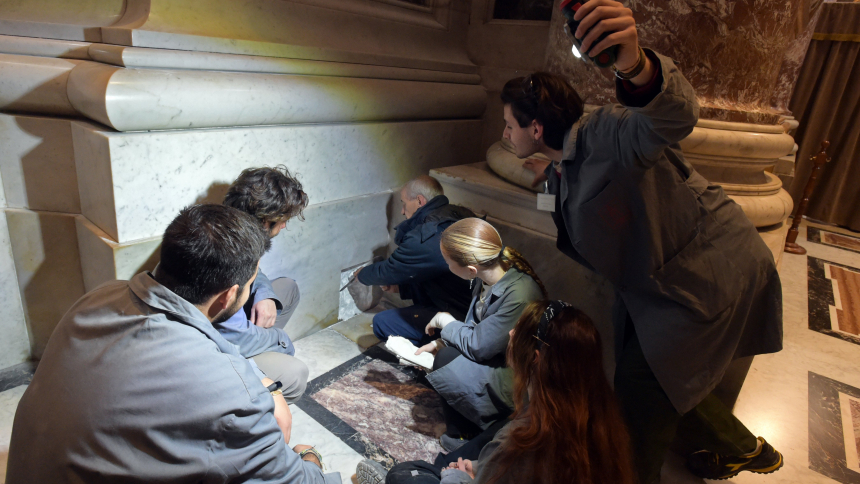
VATICAN CITY (CNS) -- When Alice Fantoni specialized in fine arts in high school, the question people posed over and over was, "But what will you do with that?"
What she did, she told Catholic News Service, was keep pursuing her passion of working with marble and stone, and she enrolled at the Academy of Fine Arts in Florence, Italy; and still people keep asking, "So, you want to be an artisan … but where will that get you?"
Turns out, it got Fantoni, 21, privileged access to the private workshops, corridors and nooks of St. Peter's Basilica, where she is one of 20 students at a unique new school dedicated to encouraging young people to practice traditional crafts and skills that risk dying out.
She has found important support, she said, thanks to people like Pope Francis and others who wanted to establish the School of Fine Arts and Traditional Trades of the Fabbrica di San Pietro.
"They wanted to set up this school precisely for this reason: to counteract a little this situation (of doubt or pushback) that comes with wanting to become an artisan or traditional craftsman" in the 21st century, she said during a special event held in the basilica's atrium April 19.
The evening event, sponsored by the Fabbrica -- the office responsible for the basilica's upkeep -- and the Fratelli Tutti Foundation, celebrated the first soon-to-be graduating class of the six-month program that launched in January.
The school offers three specialized programs: woodworking; masonry and decorative and ornamental plastering; and stonework and carving. Starting in the fall, the school will add programs for mosaics and metalworking.
Enrollment, including room and board, is completely free, just like the artisan school and apprenticeships the basilica ran centuries ago, said Pietro Zander, who is in charge of the necropolises and artistic heritage for the Fabbrica.
"That school has been brought back to life, so this knowledge doesn't get lost," he told CNS.
In his 35 years at the Fabbrica, he said, "I have seen so many exceptional craftsmen retire, then die, and they never got to pass on their skills to others."
Today, the basilica's team of "sanpietrini," the church's specialized artisans and workers, "are, for the most part, made up of men," Zander said. But "our archival documents from the 1500s and 1600s show we had masons, woodworkers, glaziers, mortar makers and cartdrivers bringing in materials by wagon to St. Peter's who were women."
Eight of the 20 students graduating in June are women, and in addition to Italians, there are students from Peru, Germany and Belarus.
The students attend lectures by top experts in their field for part of the day, followed by hands-on work and practice with the basilica's artisans.
There is also a "holistic" approach to their education in which the students live together as a community with support for their personal and spiritual growth, Jesuit Father Francesco Occhetta, general secretary of the Fratelli Tutti Foundation, told CNS.
"In Italy, we have two verbs for 'to teach.' One is 'insegnare,' which is 'to inscribe' a notion, an idea, an explanation with hours of lessons," he said. The other is "educare," which is "to bring out," to help "draw out a person's dreams, wishes and qualities that are perhaps trapped inside."
"Teaching serves really for helping a person flourish," Father Occhetta said.
When asked what has impacted her the most the past four months, Fantoni said, "Everything. I come from a really small town in Tuscany, and I only saw St. Peter's on television … and here we have our lessons right inside the basilica."
"I was able to touch Michelangelo's Pietà with my own hands, to see it up close, and to see how to make tools for working on stone," she said. "We still have another two months left so who knows what else we'll learn."
Art has been around since the dawn of humanity, she said, "so it will not disappear, but it should be encouraged."
"This school is creating new artists," she said, "and, who knows, maybe another Leonardo da Vinci will emerge."



